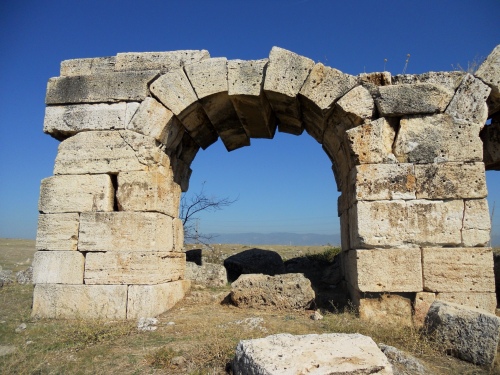Professor Ulrich – most likely coaxed by the kind-hearted Imo – acknowledged the pitiful state of the bed-ridden group and allowed us to sleep in, a concession made even more generous by the fact that daylight savings set most of Europe’s clocks back an hour in the wee hours of the morning. After a long night of rest, the group at large was visibly healthier, and was actually able to enjoy and digest a breakfast of tahini with honey and assorted spiced vegetables. Our leader’s benevolence, however, has its limits, and before leaving the hotel we endured a quiz centered around the kings of ancient Anatolia and the monuments they left behind.
The first of two sites of the day was Laodikeia, a city founded by Antoichous II in the mid-third century B.C. and named after his wife Laodike. The center remained under the rule of Pergamon from 188 B.C. until 133 B.C., when the Romans conquered the area. It is best known today for being home to one of the Seven Churches of the Book of Revelation. The largest stadium of ancient Anatolia is also found here. While many parts remain unexcavated, it is clear that it was a massive city with four agoras and two theaters. The group dispersed to explore the ruins and scavenge for pottery and coins, with varying degrees of success. We even found a graffito of a peacock in the south theater!
We left Laodikeia as our strength waned and were driven to a nearby restaurant. For many of the ill members of our group, this was their first real meal in two days. Thankfully, the Turkish pizza and apple tea sat well with all. After we’d replenished our energy, it was a short walk to our second site: Hierapolis. As we approached the site, we were greeted by a disconcerting sight: the ancient city seemed to be perched atop a tall hill whose entire side was covered in glistening snow. It was soon explained to us that what looked like snow was, in reality, a large travertine deposit that had formed into terraces as a result of the hot water pouring through Hierapolis from the mountains. The city has now become a popular tourist attraction both for its ruins and for the hot water springs that one can bathe in.
With the promise of a dip in the pools if we behaved, we dutifully followed Professor Ulrich around the site for the rest of the afternoon. A remarkably well-preserved necropolis lines the north-south road leading into the city, and much of our time was spent exploring the tombs. Once inside, we paused at the nymphaeum and spoke about the remains of an extraordinarily rare Plutoneion. We were able to see a statue of Pluto himself inside the site museum, which can also boast the ownership of the earliest depiction of a sawmill in the Roman world. Also on display were the reliefs from the scaenae frons of the theater, depicting mythological scenes such as the kidnapping of Persephone.
After leaving the museum we were set free for an hour to explore the site to our hearts content. A few brave souls took the opportunity to swim in the pools of hot water nestled into the travertine-covered hill, while others explored the less-frequented areas of the city. We reconvened at sunset on the steps of the westward facing theater, where we watched the sun disappear behind the mountains, bleeding a trail of dusty red and purple. We trudged in the increasing darkness to the edge of the mesa, took off our shoes and carefully made our way down the travertine slopes to the lights of the modern city below.
Just when we thought that the day could not get any better, we were escorted to what most agreed was the best meal we’d had in Turkey – or, dare I say, on the entire FSP. Mezes of tzatziki, vine leaves, and favas preceded a meal of stir-fried rice, assorted vegetables, and tender meat – with a side of apple tea, of course. It was a delicious, wholesome meal that banished the last of the stomach pains afflicting the ill, and was topped off by a toast from Tali, a schoolmate of Professor Ulrich who attended the FSP with him back in 1976. Tali, God bless him, distributed laminated bookmarks to every member of the group with a polaroid photo of a 22-year-old Roger Ulrich scaling the walls of Pergamon. We will treasure them forever or until we lose them – which, let’s face it, Teddy probably already has. It was a lovely finish to a lovely day.
-Cara
Photos alla Teddy:
“Dear God. A quiz before we get on the bus. This is just awful.”
Brett looking for the temple. Turn around, Brett!
Landscape pic. Sick.
Aaron throws what he knows.
Lucas seeks his fortune.
Museum in the bath complex.
Apparently swimming with ruins is a thing at Hierapolis. Who knew?
Can you find the lovebirds?
And as the sun slowly disappears, the temperatures swiftly drop…





















